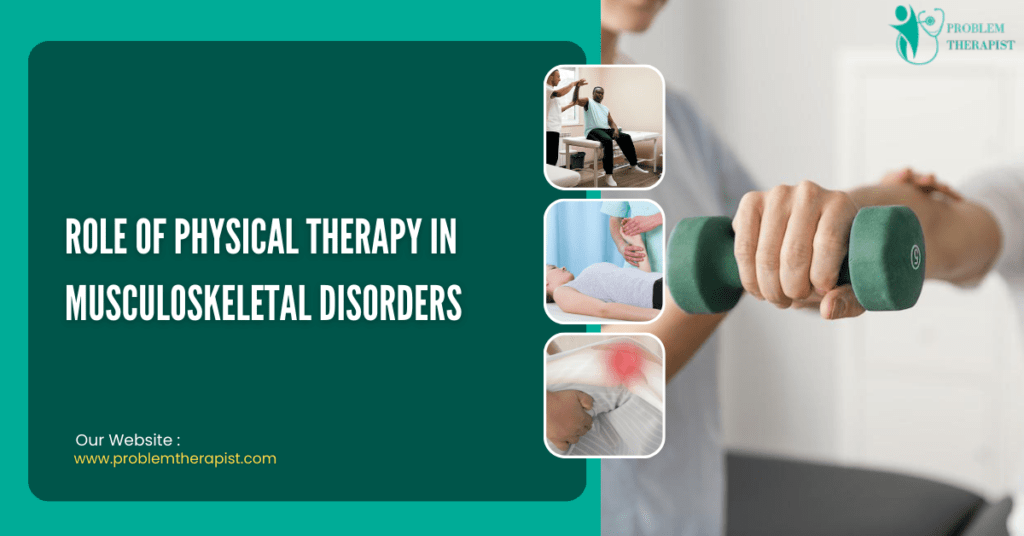Musculoskeletal disorders (MSDs) are a group of conditions that affect the bones, muscles, joints, tendons, ligaments, and nerves. They are the leading cause of disability worldwide, affecting billions of people. MSDs can cause pain, stiffness, weakness, and difficulty moving.
Physical therapy is a specialized healthcare profession that helps people who have MSBs move better and reduce pain. Physical therapists can help people of all ages, from infants to older adults.
What are work-related musculoskeletal disorders?
Work-related musculoskeletal disorders (WMSDs) are a group of injuries and disorders that affect the muscles, tendons, nerves, bones, and joints of the body. They are caused by work activities that involve repetitive motions, forceful exertions, awkward postures, or exposure to vibration. WMSDs are the most common work-related injury and illness, accounting for about 30% of all work-related injuries and illnesses.
Common WMSDs:
- Carpal tunnel syndrome: This is a condition that causes numbness, tingling, and pain in the hand and fingers. It is caused by pressure on the median nerve in the wrist.
- Tendinitis: This is inflammation of a tendon, which is a cord that connects muscle to bone. Tendinitis can occur in any part of the body, but it is most common in the elbows, shoulders, and knees.
- Rotator cuff injuries: These are injuries to the tendons and muscles that surround the shoulder joint. They can cause pain, weakness, and loss of movement in the shoulder.
- Back pain: This is a common problem that can be caused by a variety of factors, including lifting heavy objects, bending over, and sitting for long periods.
Physical therapy helps with Ankle Sprain
Benefits of Physical Therapy for Musculoskeletal Disorders
Physical therapy can be effective in treating a wide range of MSDs, including:
- Arthritis
- Back pain
- Neck pain
- Tendonitis
- Bursitis
- Fractures
- Sprains
- Strains
- Sports injuries
- Work Injuries
Physical therapists can help people with MSDs:
- Reduce pain and inflammation
- Improve range of motion
- Increase strength and flexibility
- Restore balance and coordination
- Improve posture
- Learn how to manage their condition
What to Expect During Physical Therapy
During the first physical therapy appointment, the physical therapist will:
- Take a medical history
- Perform a physical examination
- Ask about your goals for treatment
Based on the assessment, the physical therapist will develop a treatment plan that is tailored to your individual needs.
Treatment may include:
- Exercises
- Manual therapy
- Modalities such as ice, heat, electrical stimulation, and ultrasound
- Education on how to manage your condition
How Long Does Physical Therapy Last?
The length of physical therapy treatment will vary depending on the severity of your condition and your response to treatment. Most people see improvement within a few weeks of treatment. Some people may need to continue physical therapy for longer.
How to Find a Physical Therapist
To find a physical therapist, you can ask your doctor for a referral or search online. You can also check with your insurance company to see if they have a preferred provider network.
Conclusion
Physical therapy is a safe and effective treatment for MSDs. If you are experiencing pain or difficulty moving, see a physical therapist to learn how they can help you.
Here are some additional tips for finding a physical therapist:
- Ask your doctor for a recommendation.
- Check with your insurance company to see if they have a preferred provider network.
- Read online reviews.
- Ask about the physical therapist’s experience in treating MSDs.
- Make sure the physical therapist is licensed and insured.
Physical therapy can help you manage your MSD and improve your quality of life.
In addition to the benefits listed above, physical therapy can also:
- Help you avoid surgery
- Reduce your need for pain medication
- Improve your overall health and well-being
If you are experiencing pain or difficulty moving, see a physical therapist to learn how they can help you.
I am a highly skilled and experienced content writer with a Doctorate in Therapy degree. With a deep understanding of the human body and a passion for health and wellness. I combines my clinical expertise and writing skills to create valuable and engaging content.



You have observed very interesting details!
ps decent internet site.Money from blog